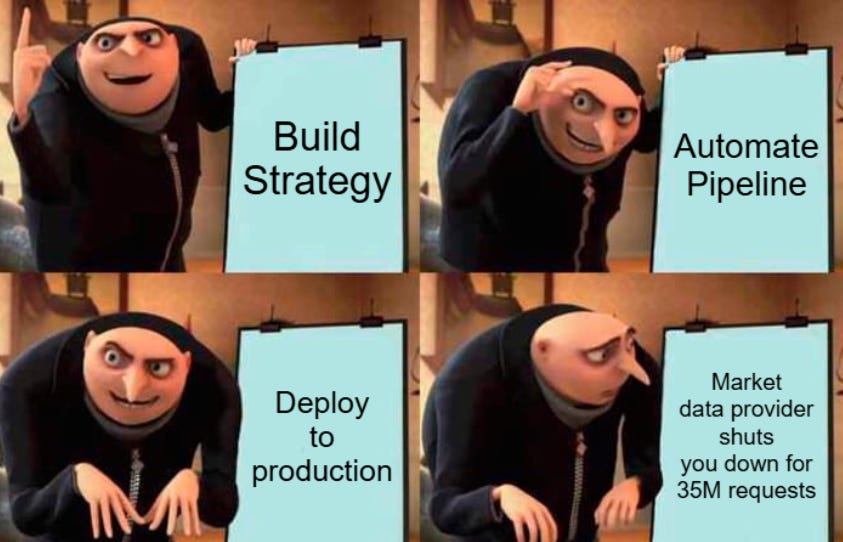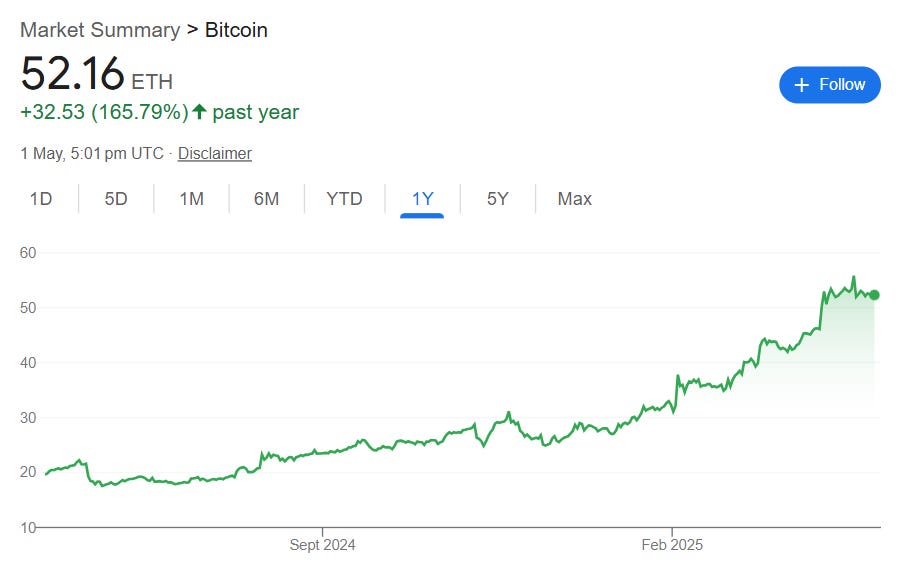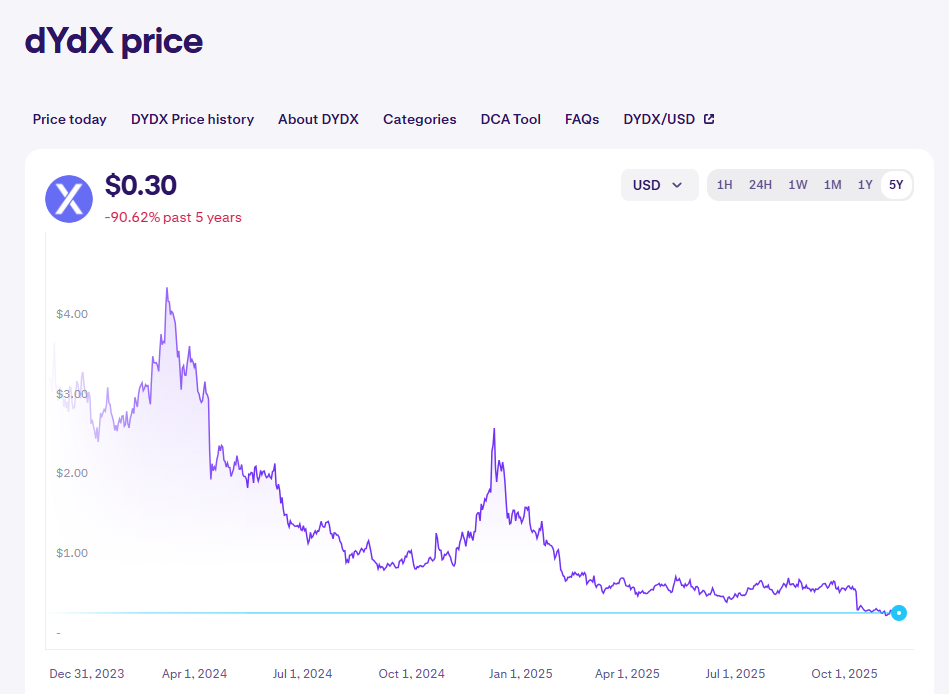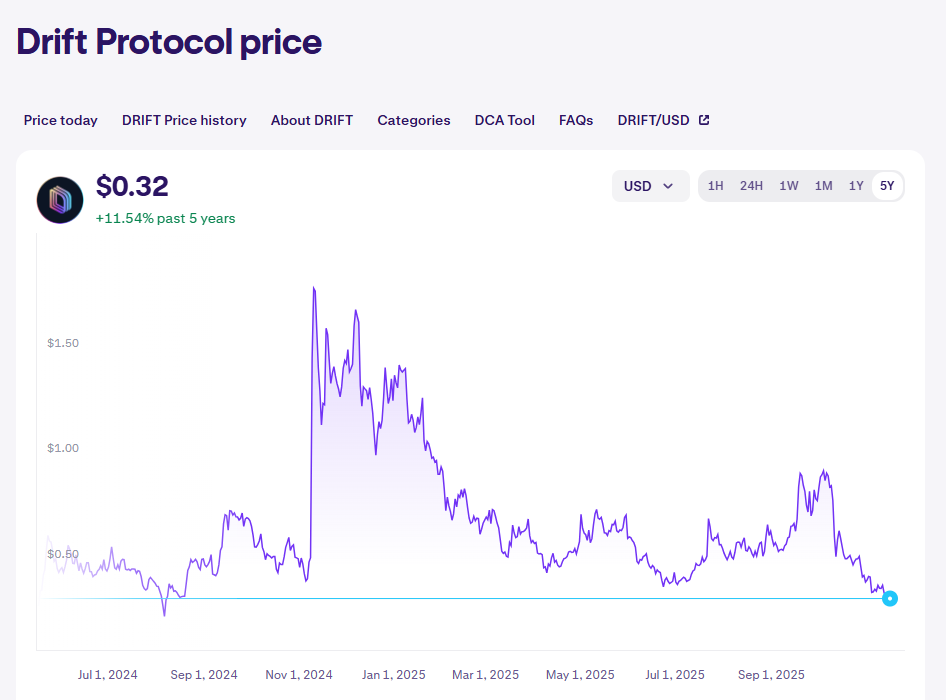Quantitative Trading Is Awesome.
Notes From the Early Days of a Real Quant Operation
Imagine a business model where, before earning your first dollar, you must spend years building a research lab: data infrastructure, strategy development, and soft-launch pipelines just to get real-world feedback on your ideas.
A rational person might look at that structure and walk away to do literally anything else.
But not us.
As we’ve transitioned from pure research into actual live trading, our public content output has tapered, but our internal knowledge and experiential nuance have grown exponentially.
Today, we want to open the curtain and share insights that only come from being fully immersed in the trenches; insights that we guarantee you simply won’t find anywhere else.
We want to again thank you for reading, for sticking with us, and for being part of this journey.
So, without further ado, let’s get right into it.
The 35 Million Request Problem
We need to admit to something… not great.
During our research-lab phase, we wanted readers to be able to replicate our experiments in real time. This served two purposes:
To give other budding quants real, hands-on tools to work with.
To help surface any errors or blind spots in our processes.
To replicate our strategies, you needed data – specific, granular, and lots of it. We assumed we were small enough that leaving an API key or two inside a code snippet would simply give a few people a head start before they eventually built their own pipelines.
In hindsight, we had no idea how the internet actually works.
On a perfectly normal, sunny day, we received a rather serious note from our data provider:
What we intended as a quiet “leg up” for a handful of readers somehow escalated into 35 million API requests across 700+ unique IP addresses — in 30 days.
To be fair, most of this was likely from forgotten cron jobs or plug-and-play servers. But the scale was… interesting.
Rightfully, our provider immediately shut off our keys pending further review.
However, it wasn’t long before this “oopsie” turned into a genuine moment of panic.
You see, for quite some time now, our main bread and butter has been short selling.
Specifically: shorting baskets of structurally weak microcaps; the <$50M names experiencing sharp, idiosyncratic volatility spikes. It’s a niche, but a highly effective one… as long as the data keeps flowing.
So, when the access first cut off, our initial reaction was, “Okay, one day off; tough, but survivable.”
But then, the second-order effects hit us.
Our entire short-selling operation is a tightly coordinated orchestra:
Market-cap classification jobs (requiring up-to-date shares-outstanding)
SEC-filing retrieval jobs that depend on those classifications
Realized volatility forecasting jobs that depend on those filings
And finally, the daily basket constructor that depends on the forecasts
If the data stops, the whole machine stops. Not just the trades — everything. And this is just for one strategy.
A single point of failure at the provider level could take our entire infrastructure offline. For a strategy that lives and dies on early-morning responsiveness, it was simply unacceptable.
So, we bit the bullet and spun up a new subscription, temporarily increasing our operating costs by a few thousand per year. Expensive? Yes. But the alternative was worse; way, way worse.
In theory, the solution is simply “just use multiple providers.”
But in reality, market data is still fragmented, with differences in universes, schema quirks, and cost structures that make multi-provider redundancy far from trivial. With that being the case, it’s not totally unreasonable to build around one primary source.
Nevertheless, it was a rather interesting and illuminating experience.
Now, onto other matters of business.
Our Equity Trading Engine
Our core U.S. equity short-selling strategy remains largely unchanged. You can get a deeper dive of what we’re doing here:
Now, one drawback of this strategy is that the opportunity set can be relatively constrained. Some days will simply not have any prediction outputs and we thus sit it out. Some days, there are valid outputs, but there are no shares available to locate (we’re already using specialized locate brokers, so these are the super-capacity constrained nano-caps).
Most days though, we’re able to efficiently get down size and operate in a systematic manner.
However, while the opportunity set is variable, the cost of operations is not; and it only goes one direction: up.
On the surface it may appear as plain greed, but we came to think that we needed a way of continuously having at least some exposure — always, 24 hours a day, we need to be exposed to some sort of opportunity set that can keep the cashflow pumping.
With that mission set, it didn’t take long before we revisited an old friend.
Building a Crypto Desk
The beauty of crypto is that it trades 24/7, has an extremely wide opportunity set, and now with the invention of decentralized exchanges and perpetual futures, comes with the ability to run sophisticated strategies at scale.
However, the inherently decentralized nature of crypto makes building any suitable infrastructure rather challenging.
You see, with stocks, price data comes from Standard Information Processors (SIPs), corporate actions data comes from the SEC EDGAR database, and the exchanges operate within a specific time window.
In crypto, almost none of this is true:
Most idiosyncratic flow of a token is driven by Twitter accounts or other influencers.
Only the tokens with the deepest liquidity “graduate” to being listed on major exchanges
This creates a selection bias for a short-oriented trader as your universe is constrained to the “best” that were able to garner enough liquidity / interest.
There are no true “official” data sources (excluding oracles).
One data aggregator (e.g. coingecko) might combine price data for a token taken from 5 exchanges, but one of the exchanges might only include data when a trade on that specific exchange is made, so when the aggregator includes data over that period, it can end up looking very different from the prices actually observed at the respective timestamp.
In other words: the data is messy, uneven, and inconsistent.
Nevertheless, we never shy away from a challenge; after all, there is always an edge in doing hard things others aren’t willing to.
So, we’ll walk you through how we were able to establish a small foothold in the space.
Porting Equity Models Into Crypto
At the end of the day, crypto is a market like any other: certain assets behave in certain ways for specific reasons.
So, we figured that to start, we’ll just port over some equity trading logic.
On our first venture into the space, we explored a simple strategy of simply going Long BTC and short ETH. The rationale was that this was effectively a relative value trade between the S&P 500 (BTC) and the Russell 2000 (ETH).
Now, for awhile, this was an extremely effective and high-sharpe trade:
Eventually though, the trade experienced a massive unwind and has since struggled to recover:
Although, this sucked, it didn’t really change anything about the core mechanism of a long-short strategy.
So, we thought:
“If Bitcoin is the bellwether of crypto, perhaps we just needed to be more creative in what we shorted against it.“
The rationale for choosing ETH was that it was the “little brother” of Bitcoin, but with some effort, we could probably find something with a stronger reason for why the trade should exist.
After some experimentation, we stumbled on something interesting: exchange tokens.
In order to understand how we got here, we should first take a cursory glance at how many exchange tokens work:
Perpetual futures are futures based on a given coin and they never expire.
In order to keep futures prices in line with spot prices, funding payments are made to incentivize traders to close the gap.
If the futures price for BTC is 95000, but the spot price is 96000, the exchange will give you payments for buying the futures such that the price can move closer to spot.
If the futures price for BTC is 95000, but the spot price is 94000, the exchange will give you payments for shorting the futures.
These payments are typically paid out in the exchange’s native token, not in something like Bitcoin or a USD stablecoin.
Because these tokens are not really worth much on their own, traders are incentivized to quickly convert them to cash or other tokens as soon as they’re received.
If you were entitled to $500 of payments and receive them in $XYZ, is it +EV to immediately convert to USDC/T and lock-in that $500 or to hold on to $XYZ and hope for stability or a rise in price?
This structure of traders being incentivized to sell, creates, in theory, a continuous selling pressure, causing most exchange token prices to look like this:
We wouldn’t necessarily just outright short these, but can we plausibly assume that Bitcoin will hold their value better than these tokens?
To see, we first ran a basic test strategy as follows:
On day t, we purchase $x of Bitcoin and short an equivalent amount of a basket of these exchange tokens.
This portfolio is held for 7 calendar days before closing and rebalancing.
We profit if the exchange tokens deteriorate more than Bitcoin over the time period:
If the overall market goes up, we assume Bitcoin will go up more than the short basket.
If the overall market goes down, we assume the exchange tokens will decrease in a greater magnitude than Bitcoin will.
Here’s the quick, gross baseline performance:
Although the baseline results were impressive, we’ve been in this business long enough to know that it’s important to immediately go to prod to figure out what the real nuances or gotchas are; so that’s exactly what we did.
Now, running a portfolio-based approach reduces lots of risks, with the average variance of each trade being ~+/-3%.
However, although it reduces risk, it also means you have to put up more capital for the trade to be “worth it”.
So before diving in, we created a crude risk metric that’s essentially the historical 3 standard deviation drawdown. For this approach, that figure was about -10% – so, for any given cycle there is theoretically a 95% chance that we don’t lose more than 10%.
With perpetual futures, most exchanges offer leverage sizes often up to 125x. If we put 10x leverage on this portfolio, we would get liquidated in the event that the total value of the portfolio suddenly decreases by 10%. We figured this to be unlikely based on the core drivers of the strategy and by historical measures, so that’s exactly what we did.
We first opened up a test trade on GMX, one of the more established DEXs (decentralized exchanges):
Interestingly enough, funding rates were in our favor, so we actually received an additional payment for the position.
The payout was in GMX token, so we of course immediately sold it for USDC.
Now, although we got off to a positive start, we experienced our first “gotcha”.
You see, GMX operates on what’s known as “isolated margin”. This means that each leg held is levered as its own unit. This is unlike “cross margin” where the leverage is spread across the portfolio.
Since we’re running it at 10x size, this means a leg would be liquidated if it went down by more than 10%. The whole portfolio wouldn’t be liquidated, but that single leg would.
Remaining equal-weighted is crucial for this strategy, so it would be unacceptable if we a leg closed out and the overall position exposure changed to an undesirable weight (e.g., 75% BTC, 25% exchange tokens as opposed to the ideal 50/50).
Thankfully, we caught this before it happened, so we then began to seek alternative exchanges that supported cross-margin.
This journey created another “gotcha” itself:
Most DEXs “restrict” U.S. clients
The workaround for most is a VPN with a dedicated IP address, such that it’s always from the same address in a “friendly” country (e.g. Netherlands)
There are many anecdotal posts of the exchange freezing withdrawals when the user accidentally logs in from a restricted country (e.g., U.S., Singapore) without first putting the VPN on
Platform risk
Because there are no central regulatory bodies, many exchanges simply just go under. Scams, blowups, whatever.
Search for reviews of any given DEX and there will be no shortage of disgruntled users claiming it’s either a total scam or the greatest thing ever.
We eventually found a few seemingly legit exchanges, but we know better than to go all-in on account of those risks, so we’ve spread out the notional exposure across multiple exchanges as a preemptive hedge.
Now, the final gotcha we’ve seen so far is that despite these being relatively obscure tokens, there are indeed legitimate idiosyncratic price drivers.
For instance, a name in our short basket, DyDx, recently approved a new proposal that would direct 75% of trading fees collected into buybacks of the DyDx token:
This led to a short-term rally in the price, although it has since continued its downward trend and correlation to other exchange tokens.
The incentive to sell hasn’t changed, but the new deliberate open-market buybacks may provide a floor of sorts, in theory.
Nevertheless, it demonstrates that these are still legitimate assets tied to real-world information flows, so we certainly aren’t calling the approach risk-free.
As of writing, we’re running the strategy at the same 10x size on the same n-day rebalancing schedule, so until the next gotcha comes up, this is what we’re doing in crypto.
Final Thoughts
When we first entered this business, we were relative novices: running endless backtests, treating markets like a pure math puzzle, and ultimately going in circles.
Over time, that evolved into something more disciplined: grounding every idea in economic rationale, not just statistical artifacts.
Once the infrastructure was built, we took the leap and entered live markets with one mandate: generate returns or go bust.
And we’re here to tell you: it is possible.
It’s extremely difficult, taxing, resource intensive, variable, and your GitHub dashboard might look like this for a few years:
But it’s possible.
If you’re willing to endure the grind, refine your systems, and stay in the arena long enough… you’ll start to see what we’ve seen.
Good luck, and happy trading. 🫡🫡















